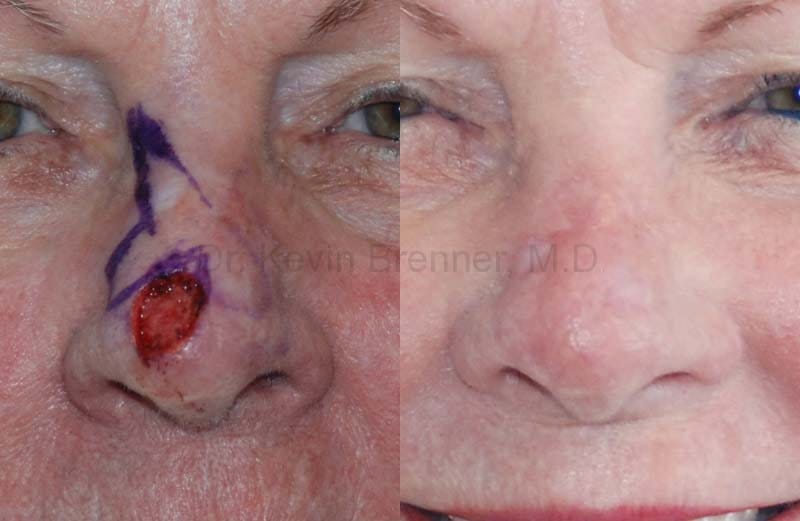Skin Cancer: Types and Prevalence
Skin cancer is a widespread problem across the country, particularly in Southern California. The three main, most-commonly seen types of skin cancer include basal cell carcinoma, squamous cell carcinoma and malignant melanoma.
Skin Cancer Treatment and Repair
Skin cancer can arise on any skin surface. It’s most common for skin cancer to develop in areas that are chronically exposed to sunlight, such as the face and hands. It is in the hands of dermatologists to diagnose and treat the overwhelming majority of skin cancers. However, removing skin cancers can sometimes leave a very large defect, requiring the skill of a specially trained plastic surgeon to repair it.
Dr. Brenner has the necessary training and experience to effectively repair facial defects caused by skin cancer. He works with many dermatologists throughout the country.


Gallery
View GalleryFacial Skin Cancer Repair: Expert Techniques
Most skin cancers that arise on the face occur in aesthetically critical areas, such as the nose, lips, eyelids, cheeks and ears. Repairing these types of defects requires an intricate understanding of the underlying facial anatomy. Dr. Brenner has years of experience and very high patient satisfaction with repairing these extremely difficult problems.
Dr. Brenner is highly experienced in this and other advanced techniques. In this technique, reconstruction takes place in two stages.

Nasal Skin Cancer Repair: Two-Stage Procedure
The first stage is nasal skin cancer repair in which a template is made of the unaffected side of the nose and transposed to the affected side. In some cases the unaffected remaining portion of the subunit is removed entirely and a piece of ear cartilage is used to provide structure to this portion of the nose. Following this, a nasolabial flap is designed and dissected. The flap is then thinned out and sewn into place along three sides. The fourth side is left attached to the original donor site and allowed to heal for about three weeks.
After three weeks of healing, the second stage of the nasal skin cancer repair is performed. During the second stage, the flap is divided, contoured to look like the structure that it is replacing and then inset with sutures.
The remaining portion of the cheek is also contoured during this second stage operation. Occasionally, patients will return for a final third contouring procedure. This is usually done three to six months later.
- Bilobed flap
- Nasolabial flap
- Forehead flap
- Rhomboid flap
- Mustarde flap
- Full thickness skin graft
- Ear Cartilage graft
Repair of skin cancer of the nose
Skin Cancer Repair on the nose can be a very challenging problem to repair. Basal Cell Carcinoma and Squamous Cell Carcinoma are found very commonly on the face. These non-melanoma types of skin cancer are particularly common on the nose. Reconstructing defects following removal of skin cancer from the nose is a particularly difficult surgical problem. When a tumor destroys a portion of the nasal ala (nasal wing), a common repair technique is to use a naso-labial flap.
Dr. Brenner is highly experienced in this and other advanced techniques. In this technique, reconstruction takes place in two stages. The first stage is nasal skin cancer repair in which a template is made of the unaffected side of the nose and transposed to the affected side. In some cases the unaffected remaining portion of the subunit is removed entirely and a piece of ear cartilage is used to provide structure to this portion of the nose.
Following this, a nasolabial flap is designed and dissected. The flap is then thinned out and sewn into place along three sides. The fourth side is left attached to the original donor site and allowed to heal for about three weeks. After three weeks of healing, the second stage of the nasal skin cancer repair is performed. During the second stage, the flap is divided, contoured to look like the structure that it is replacing and then inset with sutures. The remaining portion of the cheek is also contoured during this second stage operation. Occasionally, patients will return for a final third contouring procedure. This is usually done three to six months later.
If you're interested in learning more about Dr. Brenner's nose surgery procedures, you can visit his nose surgery page. Please feel free to call or email us with any questions or to schedule a consultation with Dr. Brenner.
Learn More About Dr. Brenner
- Renowned Beverly Hills Plastic Surgeon
- Board-certified plastic and reconstructive surgeon
- Board-certified general surgeon


